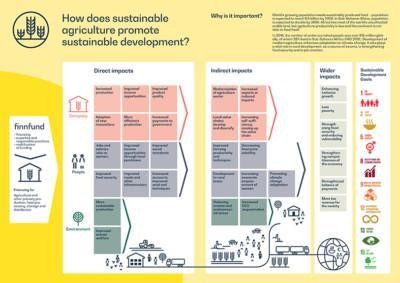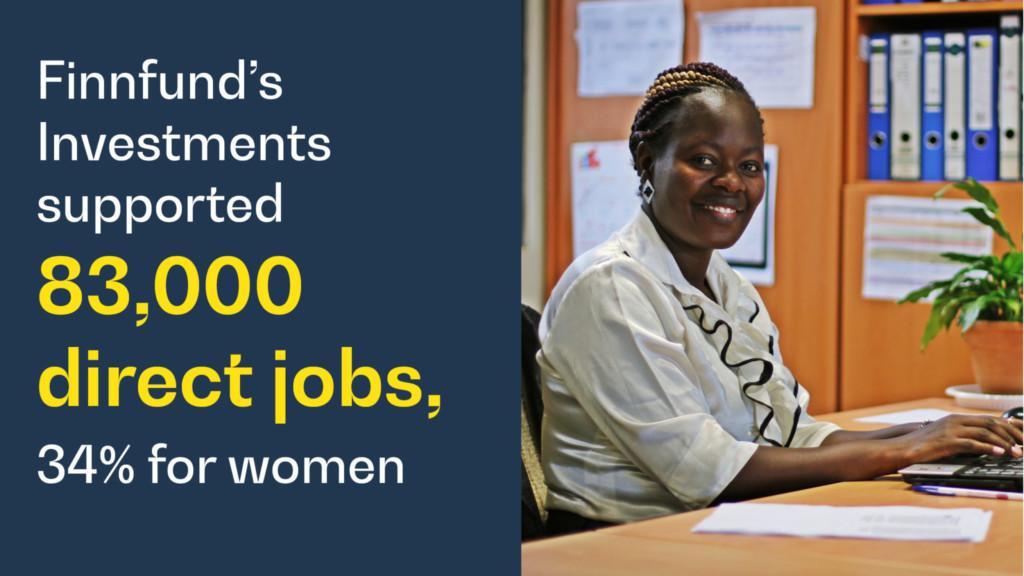Development impact assessment
Finnfund assesses and monitors the development impacts of its investments throughout the life cycle.
Preliminary screening plays an important role in the decision-making process; when Finnfund decides whether or not to start financing the project.
Theories of Change as a basis for the development impact assessment
The role of the development finance institution is to finance companies and their projects, it does not actually implement them. Firstly, the financier may influence the development impacts of its investments by focusing on projects that have the greatest potential for development impacts. The basis for development impact assessments are sector-specific Theories of Change, which describe the potential of the investment to affect major development challenges and contribute to the Sustainable Development Goals.
Development impacts are assessed on three different levels: direct impacts on business operations, indirect development impacts, and wider impacts on society.
 Theories of changes have been made for five key sectors:
Theories of changes have been made for five key sectors:
- Renewable energy
- Sustainable forestry
- Sustainable agriculture
- Financial institutions
- Digital infrastructure and solutions
Ex ante assessment of investments
Potential development impacts of every project are assessed prior to the investment decision.
This ex ante assessment focuses e.g. on the strategic relevance of the project, the importance for the market development of the target country, and the financial and other additionality of Finnfund’s participation. It is also important to assess the impacts from the perspective of the poor and women.
The key tool for ex ante assessment is DEAT (Development Effect Assessment Tool). It is based on the Theories of Change, and the common work of Development Finance Institutions for the development of impact assessment and measuring the impacts, taking into account best practices in the field. The tool is used to assess the anticipated development impacts during the preparation phase by using qualitative and quantitative indicators. In addition, information obtained during the preparation phase, assessment of environmental and social responsibility and other information, for instance, on the markets, are used in the assessment.
This assessment plays a key role in the decision-making. In addition, baseline indicators are determined for monitoring of the investment. Assessment and monitoring will continue throughout the life cycle of the investment.

Monitoring throughout the investment life cycle
Companies report to Finnfund on the development impacts annually. The monitoring of development results is based on indicators collectively agreed on by international development finance institutions (HIPSO), which are compatible with the IRIS indicators developed by the Global Impact Investing Network (GIIN). Some of the key results are published annually on Finnfund’s Development Results (since 2017 available also in English).
In addition, Finnfund conducts evaluations, made both by its own and external experts, on individual investments or, for example, on particular sectors.
Influence of the financier varies
The development results are collected as a whole from each company. The results have not been attributed or separated according to Finnfund’s share of the funding, as an internationally reliable method which could take into account the characteristics of different financing instruments, has not yet been developed. In development funding, it is typical that in addition to the investment amount, the impact depends on the characteristics of the financial instrument (e.g. loan, equity investment, mezzanine financing, securities), the risk level of the project, degree of involvement of the investor, and the ability to influence, for example, catalysing external funding, reducing risks or developing responsibility.
An exception to this is the measurement of climate effects, where the results are directly attributed according to Finnfund’s share of the funding. Finnfund, however, actively follows the discussion on attribution and the development of methods and is engaging in cooperation with other European development finance institutions.
Read more:
Development impact
Development impact assessment tool (DEAT)
Impact stories
Reports and publications
Development impact
Finnfund’s role is to promote economic and social development of developing countries.
Reports and publications
Interested to know more? Read our latest reports and publications.
Sectors
Finnfund puts special emphasis on sectors that are critical to sustainable development.
